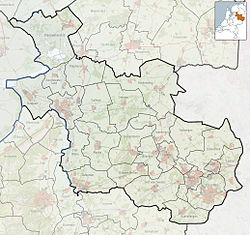Nijverdal | |
|---|---|
 National Park Sallandse Heuvelrug National Park near Nijverdal | |
 | |
| Coordinates: 52°22′N 6°28′E / 52.367°N 6.467°E | |
| Country | Netherlands |
| Province | Overijssel |
| Municipality | Hellendoorn |
| Area | |
• Total | 8.03 km2 (3.10 sq mi) |
| Elevation | 11 m (36 ft) |
| Population (2021)[1] | |
• Total | 25,000 |
| • Density | 3,100/km2 (8,100/sq mi) |
| Postal code | 7441-7443[1] |
| Dialing code | 0548 |


Nijverdal (Dutch pronunciation: [ˈnɛivərˌdɑl]) is a town of approximately 25,000 inhabitants in the Dutch province of Overijssel.[1] It is the commercial centre and largest town within the municipality Hellendoorn.
Nijverdal (which means Industrious Valley) was founded in 1836 on the territory of the hamlet Noetsele. It was here that the Industrial Revolution in the Netherlands took root. Thomas Ainsworth (1795–1841) and Zak Dee Patmore (1799–1838) were two of its founding fathers. Textile production was the focus of industrial activity in Nijverdal, as it was for the rest of the Twente region. Some of the traditional factory buildings in the Art Deco or Jugendstil style still remain.
A river called the Regge runs through the town, and is the historical border between the two regions Twente and Salland, and the border of two Dutch dialects, which are Twents and Sallaands, respectively. Every native inhabitant of Nijverdal used to speak either one or both regional dialects but since the 1970's dialect is in decline. Very few inhabitants younger than 30 use any dialect anymore.
- ^ a b c d "Kerncijfers wijken en buurten 2021". Central Bureau of Statistics. Retrieved 13 April 2022.
three entries
- ^ "Postcodetool for 7441AA". Actueel Hoogtebestand Nederland (in Dutch). Het Waterschapshuis. 24 July 2019. Retrieved 13 April 2022.


